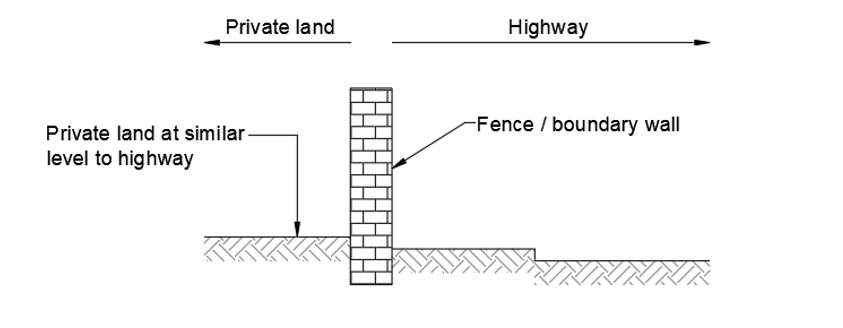
Guidance on retaining wall responsibilities
The legal and procedural requirements for retaining walls can be complex. This is Bradford Council’s guidance note on the requirements for retaining walls.
In any case where there is a dispute or the responsibility for a retaining wall is unclear or challenged then advice will be sought from the Council’s legal team before making any final decision on the responsibility for the structure.
The City of Bradford Metropolitan District Council (CMDBC) guidance on retaining wall responsibilities.
Definition
Highway wall
A wall which was constructed by the Highway Authority as part of the creation of the highway and which performs a highway function. These walls are maintainable by the Council as the Highway Authority at public expense.
Private wall
A wall constructed for the protection or benefit of the adjoining land to provide a more secure or usable space (for example, levelled land for use as a garden). Generally, private walls would have been constructed after the adjacent highway was built and are not deemed to perform a highway function. These structures are not considered to form part of the highway and are maintainable by the adjoining landowner.
Retaining wall (see sketch below)
A retaining wall is a structure which supports land (for example, embankments, field, garden etc) above the level of the adjacent highway. A retaining wall can be either a highway wall or a private wall. Typically, a highway retaining wall will not include a parapet section (that is, the wall will be approximately the same overall height as the retained land).
Burr wall (see sketch below)
A burr wall is a structure which directly supports the highway above the level of the adjacent land (For example, embankments, field, garden etc). A burr wall can be either a highway wall or a private wall. Typically, a highway burr wall will also include a parapet section above highway level, usually, but not always, approximately 1.1m high.

Note: The above sketch is for illustrative purposes only.
Fence wall or boundary wall
A fence wall or boundary wall is a non-retaining wall (that is, ground level on both sides of the wall is the same or with minimal difference). These walls form a boundary between the highway and private land and do not perform a highway function. Fence walls or boundary walls are always private structures.

Note: The above sketch is for illustrative purposes only.
Determining the responsibility for maintenance
For most modern highways, the responsibility for the maintenance of the retaining/burr walls will be recorded on CBMDC Highway Structures files or related information sheets. In cases where such records don’t exist, the responsibility for the maintenance may be outlined in the Deeds of Conveyance for the adjoining land which is usually held by the landowner. This responsibility may be recorded in the form of an easement granted to the Highway Authority for access for maintenance, or in some other form. However, it is not uncommon for property deeds to omit details of retaining/burr walls. This omission does not automatically imply that the Highway Authority is responsible for the wall.
In many cases the construction and maintenance of retaining/burr walls was dealt with as ‘accommodation works’ and responsibilities agreed in an exchange of letters between the Highway Authority and the landowner, without any reference being incorporated in the Deeds of Conveyance. Such letters may now be missing or destroyed. Nevertheless, the identification of the maintenance responsibilities where there is doubt, should generally be attempted by thoroughly searching the Highway Structures files and the legal documents library in Legal Services, requesting information from the Land Registry and examining the Deeds of Conveyance provided by the landowner. No responsibility for the maintenance of a retaining/burr wall shall be accepted without an examination of the Deeds.
Where the searches mentioned above do not reveal any relevant evidence, then the responsibility for maintenance shall be determined by the likely purpose for which the wall was built which can be assessed by the following methods.
Site visit
A site visit will be undertaken by a member of the Council’s Highways Structures Team. The site visit will include an inspection of the structure, noting the construction style to check that it is consistent with that of highway walls of similar age. Also, a broad view of the general lie of the land will help determine if a wall was required as part of the creation of the highway. The site visit will also make note of the adjoining land and whether this has been modified in any way.
Review of historical information
The Council has access to historical information, such as map information dating from 150+ years ago. This information can assist in determining when a wall was constructed. Furthermore, the Council may ask the adjoining landowner to check their own records (for example, property deeds) for information relating to the wall.
Site investigation
For retaining walls, the purpose for which it was built can often be determined by the digging of a trial hole, or by taking a borehole (possibly by hand auger), a short distance behind the wall. If the retaining wall is found to be supporting the original ground and enabling the highway, then it can be assumed to have been constructed for highway purposes. If the retaining wall is found to be supporting filled ground then the converse should be assumed to apply and it will be the responsibility of the landowner.
Where a retaining wall is of similar age and construction as the property it supports, boreholes or trial holes will often not be necessary since it can be assumed that the wall was constructed to support the property, and hence is the adjoining landowner’s responsibility.
It should be noted that the borehole investigation method is generally not suitable for burr walls where the highway is at the higher level.
Unauthorised modifications to highway walls
On occasions where unauthorised modifications have been made to highway walls such as raising or lowering of adjacent ground levels or modifications to the wall itself, the Council will not accept responsibility for these alterations. The maintenance responsibility for the wall will be considered to have passed to the adjoining landowner and the wall now deemed to be a private structure.
Notes
Whether or not the retaining wall was built for highway purposes can only be decided by the Strategic Director of the Department responsible for retaining walls after inspection of conveyance, Council land records, bridges records, and most importantly the site.
There may be rare occasions when conveyance or legal agreement specifies responsibility and this would over-rule the generalities outlined above.
Section 167 of the Highways Act 1980 does not apply to retaining walls with a retained height of less than 4ft 6ins high and therefore if these collapsed they would be dealt with as ‘materials deposited on the highways’, ‘dangerous land adjoining Street’ or ‘danger to Highway users’ under the Highways Act.
Summary
A. Burr walls
| Type of wall | Responsibility | Other comments (non exhaustive) |
|---|---|---|
| 1. Provided when the highway was constructed. | Highway Authority (HA) unless other agreement. | |
| 2. Provided when the road was altered in line or level for private needs – canal, railway, etc. | Private. | HA may have to take action if the owner fails to do so. HA will seek to recover costs from the asset owner. |
| 3. Originally not retaining but now retaining due to decrease in level of adjacent land. | Private. | HA may have to take action if the owner fails to do so. HA will seek to recover costs from the asset owner. |
| 4. Walls formerly incorporated in a building and remaining after demolition or walls provided for private benefit, for example to provide level area on sloping ground. | Private. | Any wall adjoining land owned by Bradford Council should be incorporated in the sale of any plot. |
B. Retaining walls
| Type of wall | Responsibility | Other comments (non exhaustive) |
|---|---|---|
| 1. Provided when the highway was constructed. | HA unless other agreement. | |
| 2. Provided when the road or land was altered in line or level for private needs. | Private. | HA may have to take action if the owner fails to do so. HA will seek to recover costs from the asset owner. |
| 3. Originally not retaining but now retaining due to increase in level of adjacent land. | Private. | HA may have to take action if the owner fails to do so. HA will seek to recover costs from the asset owner. |
| 4. Walls formerly incorporated in a building and remaining after demolition or walls provided for private benefit, for example to provide level area on sloping ground. | Private. | Any wall adjoining land owned by Bradford Council should be incorporated in the sale of any plot. |